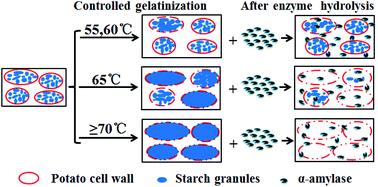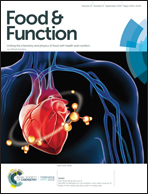Controlled gelatinization of potato parenchyma cells under excess water condition: structural and in vitro digestion properties of starch†
Abstract
Modulation of the starch digestion rate and extent is a major target for increasing nutritional value of potato-based food. In order to understand the effect of controlled gelatinization on the structure and in vitro digestion properties of whole potato food, intact parenchyma cells were isolated as a model through soaking in mild acid and alkali solutions, and then hydrothermally treated at different incubation temperatures in excess water. The morphological and structural changes of entrapped starch granules as well as in vitro starch digestion properties were investigated. Three classes of starch digestion of potato cells are identified: (1) when the temperature of hydrothermal treatment was set at 55 °C or 60 °C, the efficient physical barrier of intact cell walls resulted in a limited starch digestion extent; (2) when the temperature is set at 65 °C, the cell wall structures apparently reduced the digestion rate but only slightly reduced the final extent compared to the starch counterpart, probably because starch swelling weakens the physical barrier; (3) at 70–95 °C, the damaged cell wall still reduced the digestion rate but did not reduce the digestion extent compared to the starch counterpart. The results suggest that controlling hydrothermal processing temperature is a viable approach to develop potato ingredients with enhanced nutritional functionality.



 Please wait while we load your content...
Please wait while we load your content...